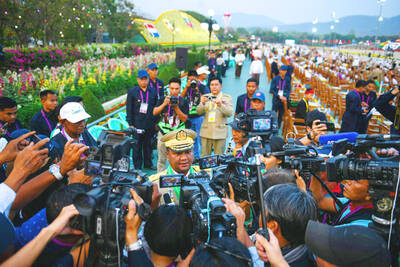Japan has made big strides toward stabilizing its tsunami-crippled nuclear plant, but is now facing another crisis — what to do with all the radioactive waste the disaster created.
Goshi Hosono, the country’s nuclear crisis minister, said on Friday that Japan has yet to come up with a comprehensive plan for how to dispose of the irradiated waste that has been accumulating since the March 11 earthquake and tsunami.
Hosono gave the assessment after the government announced a ¥900 billion (US$11.5 billion) allocation to help the cash-strapped plant operator cover the massive cost of recovery without collapsing. Officials have rejected criticism that the allocation is a bail-out, stressing that the money comes from a joint fund of plant operators, with a government contribution in zero-interest bonds that must be paid back.
The disaster, which killed nearly 20,000 people along Japan’s northeastern coastline, touched off the world’s worst nuclear accident since Chernobyl, generating meltdowns, fires and radiation leaks at the Fukushima Dai-ichi nuclear power station northeast of Tokyo.
Officials say that, almost eight months later, the plant has been restored to a relatively stable condition and is leaking far less radiation than it did in the early days of crisis. They hope to achieve a “cold shutdown” — with each reactor’s temperature below 100oC) — by the end of the year.
However, Hosono, in a response to a question from The Associated Press, acknowledged on Friday that the crisis has spawned a huge amount of irradiated waste that will require new technology and creative methods to dispose of safely.
“We still don’t have a full picture of how to deal with the waste,” he said. “It would require research and development that may take years. For instance, we still need to develop technology to compress the volume of the huge amounts of waste that we cannot move around.”
Japan could be stuck with up to 45 million cubic meters of radioactive waste in Fukushima and several nearby prefectures, according to the environment ministry.
Hosono said Japan is not considering shipping out the waste for overseas processing.
The total amount of radiation released from the plant is still unknown and the impact of chronic low-dose radiation exposures in and around Fukushima is a matter of scientific debate. More than 80,000 people evacuated from their homes, and a 20km no-go zone is still enforced around the plant.
Cleaning up the area and compensating residents is expected to cost trillions of yen. Hot spots of highly localized radiation have been reported hundreds of kilometers away. Hosono said a task force has been set up to investigate them.
The ¥900 billion fund payout announced on Friday for Tokyo Electric Power Co is meant to help the operator meet its responsibilities without going bankrupt.

Eleven people, including a former minister, were arrested in Serbia on Friday over a train station disaster in which 16 people died. The concrete canopy of the newly renovated station in the northern city of Novi Sad collapsed on Nov. 1, 2024 in a disaster widely blamed on corruption and poor oversight. It sparked a wave of student-led protests and led to the resignation of then-Serbian prime minister Milos Vucevic and the fall of his government. The public prosecutor’s office in Novi Sad opened an investigation into the accident and deaths. In February, the public prosecutor’s office for organized crime opened another probe into

RISING RACISM: A Japanese group called on China to assure safety in the country, while the Chinese embassy in Tokyo urged action against a ‘surge in xenophobia’ A Japanese woman living in China was attacked and injured by a man in a subway station in Suzhou, China, Japanese media said, hours after two Chinese men were seriously injured in violence in Tokyo. The attacks on Thursday raised concern about xenophobic sentiment in China and Japan that have been blamed for assaults in both countries. It was the third attack involving Japanese living in China since last year. In the two previous cases in China, Chinese authorities have insisted they were isolated incidents. Japanese broadcaster NHK did not identify the woman injured in Suzhou by name, but, citing the Japanese

RESTRUCTURE: Myanmar’s military has ended emergency rule and announced plans for elections in December, but critics said the move aims to entrench junta control Myanmar’s military government announced on Thursday that it was ending the state of emergency declared after it seized power in 2021 and would restructure administrative bodies to prepare for the new election at the end of the year. However, the polls planned for an unspecified date in December face serious obstacles, including a civil war raging over most of the country and pledges by opponents of the military rule to derail the election because they believe it can be neither free nor fair. Under the restructuring, Myanmar’s junta chief Min Aung Hlaing is giving up two posts, but would stay at the

YELLOW SHIRTS: Many protesters were associated with pro-royalist groups that had previously supported the ouster of Paetongtarn’s father, Thaksin, in 2006 Protesters rallied on Saturday in the Thai capital to demand the resignation of court-suspended Thai Prime Minister Paetongtarn Shinawatra and in support of the armed forces following a violent border dispute with Cambodia that killed more than three dozen people and displaced more than 260,000. Gathered at Bangkok’s Victory Monument despite soaring temperatures, many sang patriotic songs and listened to speeches denouncing Paetongtarn and her father, former Thai prime minister Thaksin Shinawatra, and voiced their backing of the country’s army, which has always retained substantial power in the Southeast Asian country. Police said there were about 2,000 protesters by mid-afternoon, although